| Article ID | Journal | Published Year | Pages | File Type |
|---|---|---|---|---|
| 4681477 | Geoscience Frontiers | 2016 | 9 Pages |
•Dyke swarms reflect stress fields or basement fabric.•Deccan alkaline complex with varied rock types in Barmer-Cambay rift.•Most dykes and the Barmer-Cambay rift trend NNW–SSE.•They do not follow structural trends of varied basement rocks.•Contemporary late Cretaceous plate-wide extension produced dykes and the rift.
Whether swarms of preferentially oriented dykes are controlled by regional stress fields, or passively exploit basement structural fabric, is a much debated question, with support for either scenario in individual case studies. The Sarnu-Dandali alkaline complex, near the northwestern limit of the Deccan Traps continental flood basalt province, contains mafic to felsic alkaline volcano-plutonic rocks and carbonatites. The complex is situated near the northern end of the 600 km long, NNW–SSE-trending Barmer-Cambay rift. Mafic enclave swarms in the syenites suggest synplutonic mafic dykes injected into a largely liquid felsic magma chamber. Later coherent dykes in the complex, of all compositions and sizes, dominantly strike NNW–SSE, parallel to the Barmer-Cambay rift. The rift formed during two distinct episodes of extension, NW–SE in the early Cretaceous and NE–SW in the late Cretaceous. Control of the southern Indian Dharwar structural fabric on the rift trend, as speculated previously, is untenable, whereas the regional Precambrian basement trends (Aravalli and Malani) run NE–SW and NNE–SSW. We therefore suggest that the small-scale Sarnu-Dandali dykes and the much larger-scale Barmer-Cambay rift were not controlled by basement structure, but related to contemporaneous, late Cretaceous regional ENE–WSW extension, for which there is varied independent evidence.
Graphical abstractFigure optionsDownload full-size imageDownload as PowerPoint slide
